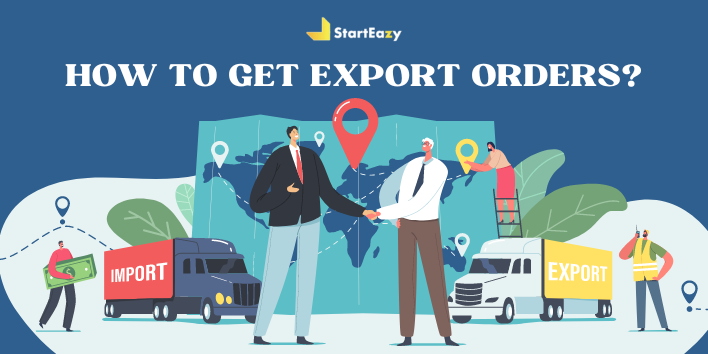How to Get Export Orders | A Comprehensive Guide

Almost every entrepreneur dreams of selling their products globally. However, many are unsure where to begin. Don't worry! We have prepared a detailed guide that walks you through every step of getting export orders online.
Before diving into the exporting journey, let’s explore some effective ways to engage foreign customers.
1. Improve Your Communication Skills
Effective communication is the first and most crucial step in forming connections with international buyers. No matter how great your product is, if you're unable to communicate its value to your potential customers, your efforts may go in vain.
In the exporting business, communication bridges the gap between you and your customers, helping you build trust and form lasting relationships.
2. Enhance Your Negotiation Skills
Negotiation is an inherent part of any business deal, especially in international trade. In India, for example, negotiation is often an expected part of transactions.
Similarly, in export markets, your ability to negotiate fairly will ensure that both you and your buyers are happy with the terms. Learn to strike a balance between offering value to the buyer while maintaining your profit margins.
3. Attend Trade Shows and Exhibitions
Trade shows and exhibitions are valuable opportunities to observe buyer behavior and the competitive landscape.
By attending these events, you can gauge which products attract customers, how sellers engage with their audience, and which strategies work best in different markets. This knowledge is crucial when entering the export industry.
4. Understand Foreign Cultures
Each country has its unique culture that influences consumer behavior. For instance, bright and colorful designs may be more appealing to Indian customers, while subtle and minimalist aesthetics may work better in the U.S. market.
Understanding and respecting these cultural differences is critical to your success as an exporter. Always ensure that your product aligns with the cultural values of your target market.
How to Secure Buyers for Your Export Products
Now that we've covered the basics, let's talk about how to secure buyers for your export orders:
Step 1 - Understand the Market Culture
Expanding into foreign markets requires a deep understanding of the local market culture, which includes consumer preferences, trends, and competition.
By conducting thorough market research, you'll gain valuable insights into how to position your product for success.
Here are four key steps to follow:
-
Analyze Your Target Market:
Understanding your target market and its nuances is essential for long-term success. Consider factors like cultural trends, consumer behaviors, and local competition when positioning your product.
-
Identify Your Unique Selling Points (USPs):
Stand out from the competition by highlighting what makes your product unique. Whether it's superior quality, innovative design, or cost-effectiveness, your USPs should be tailored to resonate with your target audience.
-
Choose the Best Marketing Channels:
To reach your potential buyers, it's essential to choose the right marketing channels. A professional website, social media platforms, and participation in trade shows can increase your visibility.
-
Set a Competitive Pricing Structure:
Pricing is a crucial aspect of export success. Make sure your pricing strategy covers direct and indirect costs while remaining competitive in your target market.
Step 2 - Create an Online Presence
In today’s digital age, an online presence is indispensable for expanding your business globally.
Here’s how to get started:
-
Why Is an Online Presence Important?
An online presence enables businesses to reach a global audience without the limitations of physical boundaries. Customers from different time zones can access your products, learn more about them, and place orders anytime.
-
How to Build an Online Presence:
Start by creating a professional website. Select a content management system (CMS) like WordPress, Wix, or Shopify. Customize your website based on your product line and brand identity.
Here are some tips for showcasing your products online:
-
Use professional photography to create visually appealing product images.
-
Implement features like 360-degree product views to enhance the customer experience.
-
Include customer reviews and a "Chat with Us" option to improve communication.
-
Offer multiple online payment options for smooth transactions.
Step 3 - Build a Network with Export Agents
Developing relationships with export agents is vital for gaining a foothold in foreign markets.
These agents can help introduce you to potential buyers and assist with processing orders. Here’s how to build your export network:
-
Attend Trade Shows and Exhibitions:
These events are great opportunities to meet agents, distributors, and potential buyers in person.
-
Create an Online Presence:
Leverage social media to connect with foreign agents and distributors. Share links to your online store and provide insights into your business.
-
Appoint Foreign Agents:
Many businesses have successfully expanded their operations by hiring foreign agents. These agents can facilitate introductions to buyers and help manage transactions. You can find agents through agencies or platforms like LinkedIn.
Step 4 - Pricing Your Products
Pricing plays a important role in gaining a competitive edge in the export market.
A well-thought-out pricing strategy not only ensures profitability but also attracts buyers, making your products more appealing in the global marketplace.
Here’s how to craft a successful export pricing strategy:
1. Cover All Costs: Direct and Indirect
Your pricing must account for both direct costs (production, packaging, shipping) and indirect costs (marketing, legal fees, and overheads).
Consider the total landed cost, which includes:
-
Manufacturing expenses
-
Export duties and taxes
-
Freight and insurance costs
-
Warehousing and logistics
2. Benchmark Against Competitors
Analyzing the pricing of similar products in your target market is essential to position yourself competitively. Take note of:
-
Competitor prices for similar products
-
How they justify higher or lower pricing (quality, features, or branding)
-
Their sales volumes and market share
This insight will help you decide whether to adopt a cost-leadership approach (lower price, higher volume) or a premium pricing strategy (higher price, exclusive value).
3. Factor in Currency Fluctuations and Inflation
Currency exchange rates and inflation rates can directly affect your profit margins, especially if there are significant differences between your local currency and that of your target market.
Keep an eye on:
-
Daily or weekly currency trends
-
Inflation rates in both your country and your target market
-
Hedging options to minimize risk associated with currency fluctuations
Building a flexible pricing model that adjusts according to exchange rate variations can help you maintain profitability across different markets.
4. Understand Your Target Market’s Pricing Sensitivity
Conduct thorough market research to assess how price-sensitive your potential buyers are.
Some customers may prioritize affordability, while others might be willing to pay more for quality or exclusivity.
To understand their perception of pricing:
-
Run surveys and collect feedback directly from buyers or distributors
-
Study purchasing behaviors of consumers in your target market
-
Test different price points (A/B testing) to determine the best balance between volume and margins
Step 5 - Showcase Your Products to Potential Buyers
How you present your products can make all the difference in gaining export orders.
Whether online or in person, a clear presentation of your product’s value is essential.
-
Online Markets:
-
Ensure your website is user-friendly and visually appealing.
-
Provide high-quality images and 360-degree product views.
-
Use social media to promote your products with engaging posts and stories.
-
-
Offline Markets:
-
Trade shows and exhibitions provide in-person opportunities to showcase your products.
-
Design an engaging booth that reflects your brand’s identity and culture.
-
Ensure your product packaging aligns with the local market’s preferences.
-
Step 6 - Build Relationships with Potential Buyers
Success in export markets often depends on the strength of the relationships you build.
Here’s how to establish lasting connections:
-
Maintain open and transparent communication with buyers.
-
Follow up regularly to ensure customer satisfaction.
-
Be dependable, and focus on delivering quality products consistently.
Trust and reliability are the cornerstones of long-term partnerships.
Register Your Business
Before you start your export journey, one of the most crucial steps is ensuring that your business is legally registered.
Legal registration not only protects your business from potential disputes but also provides you with the necessary licenses and compliance certifications to operate globally.
Why Registering Your Business is Critical
- Legitimacy and Credibility
Registering your business reassures international clients of your legitimacy, building trust and increasing your chances of securing export orders.
- Intellectual Property Protection
It safeguards your trademarks, patents, and designs, protecting your unique assets from being copied or exploited in global markets.
- Compliance with Export Regulations
Proper registration ensures you meet international export laws, avoiding fines, delays, or loss of export privileges.
- Access to Government Incentives
Registered businesses can benefit from government incentives, tax breaks, and export assistance programs, boosting your global growth potential.
How to Register Your Business with StartEazy?
StartEazy simplifies the business registration process, making it easy for entrepreneurs and established businesses to ensure full legal compliance.
Here are the steps you need to follow to register your business with StartEazy:
Step 1: Get in Touch with Our Experts
Start by consulting with our experts by filing out the form on your right. They will understand your business needs and guide you through the registration process.
Step 2: Choose Your Business Structure
Decide on the right structure for your business—whether it's Sole Proprietorship, Partnership, LLP, or Private Limited Company. StartEazy will help you choose the best option based on your goals.
Step 3: Submit Required Documentation
Once you choose your structure, you’ll need to submit the necessary documentation, such as:
-
Proof of identity and address of the owners or directors
-
Business address proof
-
Shareholder agreements (if applicable)
-
Proposed company name StartEazy will handle the preparation and submission of these documents, ensuring all forms are correctly filed with the appropriate authorities.
Step 4: Sit Back and Relax
Our team will apply for your business registration through the MCA (Ministry of Corporate Affairs) portal and coordinate with them to ensure a smooth process.
We will keep you updated at every step. Meanwhile, you can also apply for other necessary licenses like Import Export Code (IEC) and GST with the assistance of our experts.
Step 5: Ongoing Support and Resources
After registration, StartEazy provides continuous support, including tax consultancy, compliance monitoring, and export documentation assistance, ensuring your business runs efficiently on a global scale.
Conclusion
Securing export orders requires a combination of market knowledge, effective communication, and strategic networking. By following the steps outlined in this guide, you’ll be better equipped to succeed in the global marketplace.
For expert legal advice and support, feel free to consult the professionals at StartEazy by filling out the form on your right.








